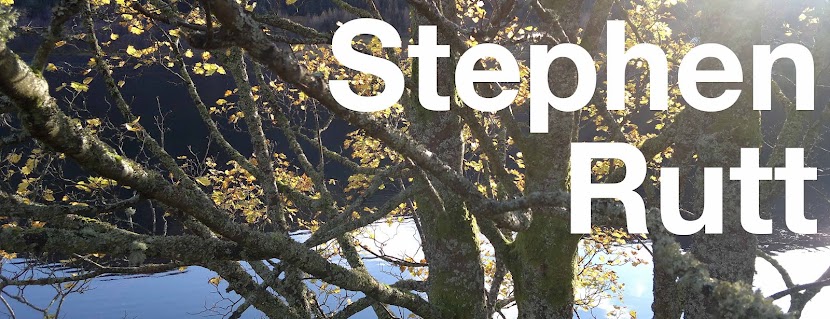Emerging from the shady wood I felt the change in atmosphere
almost instantly. The path snaked down through long grass and a hotter, more
humid atmosphere, one where you can feel the warmer air radiating up from the
grass and the sun through the layer of high cloud. The cool of the wood allowed
sweat free walking: this wouldn’t. A Dark-green Fritillary flew strongly past
the path and over the fescue covered hillside. Early August is when their
season starts winding down, after their plant and sun powered prime; its
tiger-striped wings faded from sun, wind and ceaseless flying over its own
patch of the hill. It clipped the edge of the wood and headed downslope, over a
pair – male and female – of Brimstone butterflies, as bright as the first leaves
of spring. These are signs of gradual change. It might still be summer but the
single-brooded butterflies (univoltine), like the Marbled White lying in the
long grass look faded, worn, exhausted. The double-brooded (bivoltine)
butterflies are pristine, or, like the pair of Common Blues by the edge of the
field, busying themselves with the creation a new generation to come. It’s
spring for some, eliding with the autumn of others.
***
Downland is a new habitat for me. Chalk might be the
material of southern England, these gently rolling grasslands what we as a
nation think of when we think of the rural south. But it’s never been my
England. A far removal from the fenland peat, the breckland sand and the gloopy
winter mud of my village. The soils that I grew up with that remains familiar
to the footfall.
The path underfoot is the white chalk of The Ridgeway. Not
quite the ancient track but the modern end of the national trail that connects
up to the equally ancient Icknield Way. It carves a muddy white line along this
escarpment east of Tring and feels almost like the real thing. The footsteps
feel fleeting, the trees look young and the arable farmland where the hillside
slopes into the vale can’t be too old either, not compared with the bare bone
appearance of the chalk through soil. The Red Kite skimming in slow motion the
top of the wood is young too, from reintroduced stock. I doubt they’ve been
here for more than ten years. A Roesel’s Bush-cricket stridulated from the
weeds in the verge of the long fast road running through the vale. Stridulation
– the rubbing of wing against leg – creates the evocative buzz of grasshoppers.
It’s a sound I remember well from my childhood, but not so much over my teenage
years. Not that I would’ve known it at the time but I wouldn’t have remembered
Roesel’s Bush-cricket, a species that has undergone significant range expansion
recently. I feel transitory. Not the youngest but the least rooted thing here.
My search for a species of butterfly I hadn’t yet seen would keep me here only
a few hours.
***
Past another woodland break and the land slips away to be
replaced by the spectacle of distance – I can see Oxfordshire from here! – and
weather. Across to the distant chalk escarpment on the horizon lies Aylesbury
and villages stretch off north and south. The pale clouds of earlier had fallen
towards earth, darker and heavier. Grey sheets of rain hung over Aylesbury,
apparently immobile, but with the wind blowing into our faces it was impossible
not to take a guess at the time it would hit us.
Directly ahead the downland kinked eastward; the kink hiding
the path and the rest of the downs. Up slope was long grass thick with flowers
gone to seed whose names I never properly learnt, have never been properly
introduced to. Chalkhill Blue is the butterfly we had come to see. It is so
inextricably tied to these chalk downs that it bears them as its name. As a
caterpillar it only feeds on the Horseshoe Vetch that grows on slopes like
this.
We didn’t have too long to wait.
Dad spotted it first, perched on a deep pink knapweed by the
path. Embarrassingly I’d walked past it scanning the further ground. It had its
wings shut tight to enable easy identification: much greyer underwings with
large black spots and a lack of orange in comparison to the Common Blues
downslope. It flew from the knapweed and onto the grass, opening its wings as
the approaching rain chilled the air. A silvery blue, like a sunny winter’s sky
yet an exotic touch on this darkening piece of England.
It’s not a species famed for its powers of flight and true
to form it never lifts more than several inches from the ground. Instead it
tolerates my close approach with the camera.
There was one last surprise as a pink and green Meadow
Grasshopper leaps on to a grass head by me. It scurried round to put the bulk
of the grass head between me and itself, and then carries on moving around as I
try to angle myself in a position to photograph it. Eventually it stays still
long enough for a photograph of its pink back to be obtained, before dropping
down into the grass to better observe the shuffling, grunting creature peering
down a noisy black object at it.
A few shots later I turn around. The sky is solid pewter.
Heavy rain begins to drum into the hillside, washing the chalk slippy. We ran
back to the trees.





